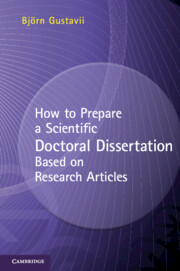Book contents
- Frontmatter
- Contents
- Preface
- Acknowledgments
- 1 Introduction
- 2 Compilation – the article-based thesis
- 3 Front cover illustration
- 4 Title
- 5 Abstract
- 6 Quotations
- 7 Thesis at a glance
- 8 Abbreviations
- 9 List of publications
- 10 Contributors
- 11 Popularized summary
- 12 Acknowledgments
- 13 General introduction
- 14 Aims
- 15 Methods
- 16 Results
- 17 General discussion
- 18 Copyright
- 19 A dissertation worth considering
- Appendix A To the authorities at the graduate division
- Literature cited
- Index
11 - Popularized summary
Published online by Cambridge University Press: 05 November 2012
- Frontmatter
- Contents
- Preface
- Acknowledgments
- 1 Introduction
- 2 Compilation – the article-based thesis
- 3 Front cover illustration
- 4 Title
- 5 Abstract
- 6 Quotations
- 7 Thesis at a glance
- 8 Abbreviations
- 9 List of publications
- 10 Contributors
- 11 Popularized summary
- 12 Acknowledgments
- 13 General introduction
- 14 Aims
- 15 Methods
- 16 Results
- 17 General discussion
- 18 Copyright
- 19 A dissertation worth considering
- Appendix A To the authorities at the graduate division
- Literature cited
- Index
Summary
Popularized summary is not used in all universities.
A thesis has three levels of language. The individual papers are written for the specialist, the overview for the non-specialist, and the popularized summary for the layperson. How do you find the level of the layperson? You may imagine a 12-year-old standing behind you, looking over your shoulder while you are writing.
When reading your popularized summary, the layperson first of all wants to know why you were captivated by the subject to such an extent that you were willing to spend four to six of the best years of your life studying it. Of course, what you did and what you found should be presented – but only briefly; this is not the place for lengthy details about your research. The layperson is also interested in the practical applications, i.e. in how treatment of diseases in human beings could benefit from your rat data.
Add elementary illustrations that you yourself may draw, so simple that they might qualify for a place in a children’s book. If you think, “If I do that no one will take me seriously,” then let me tell you that when Peter Englund, Secretary of the Swedish Academy that awards the Nobel Prize for Literature, was writing his thesis, his supervisor said that it was too easily understood: “You will not be taken seriously” (Chukri, 2008).
Information
- Type
- Chapter
- Information
- Publisher: Cambridge University PressPrint publication year: 2012
